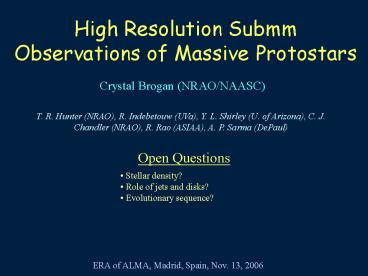High Resolution Submm Observations of Massive Protostars - PowerPoint PPT Presentation
Title:
High Resolution Submm Observations of Massive Protostars
Description:
High Resolution Submm Observations of Massive Protostars Crystal Brogan (NRAO/NAASC) T. R. Hunter (NRAO), R. Indebetouw (UVa), Y. L. Shirley (U. of Arizona), C. J ... – PowerPoint PPT presentation
Number of Views:111
Avg rating:3.0/5.0
Title: High Resolution Submm Observations of Massive Protostars
1
High Resolution Submm Observations of Massive
Protostars
Crystal Brogan (NRAO/NAASC)
T. R. Hunter (NRAO), R. Indebetouw (UVa), Y. L.
Shirley (U. of Arizona), C. J. Chandler (NRAO),
R. Rao (ASIAA), A. P. Sarma (DePaul)
ERA of ALMA, Madrid, Spain, Nov. 13, 2006
2
The Submillimeter Array Observations CepA-East,
NGC 7538 IRS1, G5.89-0.39
- Eight 6-m antennas
- 2 Sidebands each 2 GHz wide separated by 10 GHz
- 345 GHz tuning centered at 336 / 346 GHz
- Resolution 2 in compact configuration, lt1
extended - Continuum rms noise 10 mJy/beam
- Only line free channels used
- Line rms noise 300 mJy/beam
ALMA will improve resolution and spectral
sensitivity by more than factor of 25!
3
The Many Protostars of CepA-East
5
d0.73 kpc
3.6 mm
4.5 mm
8.0 mm
SCUBA 850 mm
4
CephA-East Line Forest
Spectra are similar to that of OrionA single dish
data (Schilke et al. 1997)
5
Chemical Differentiation
SMA 875 mm VLA 3.6 cm
resolution 0.6
nprotostars 8 x 105 pc-3
6
CepA-East Temperatures
CH3OH Trot153 6 K
SMA2
SO2 Trot292 50 K
CH3OH and SO2 corrected for optical depth
effects. For CH3OH, max t30! Trot 2x higher than
reported by Martin-Pintado et al. (2005) based on
30m data probably a beam dilution effect
HC3N Trot496 70 K
HW2-NE
7
Velocity Gradients Dont Always Equal Rotation
Insufficient spatial resolution causes apparent
velocity/position gradient No evidence for a disk
as reported by Patel et al. (2005)
8
Velocity Gradients Dont Always Equal Rotation
Insufficient spatial resolution causes apparent
velocity/position gradient No evidence for a disk
as reported by Patel et al. (2005)
9
NGC7538 IRS1
Spitzer
9
d2.8 kpc 25600 AU
3.6 mm
IRS2
IRS3
4.5 mm
2
8.0 mm
IRS1
10
NGC7538 IRS1
Spitzer
9
d2.8 kpc 25600 AU
3.6 mm
IRS2
IRS3
4.5 mm
2
8.0 mm
IRS1
11
NGC 7538 Line Forest Comparison-I
CepA-East
NGC 7538 IRS1
12
NGC 7538 Line Forest Comparison-II
CepA-East
NGC 7538 IRS1
13
Distribution of Molecules in NGC7538 IRS1
2
CH3OH
HC3N
SO2
C2H5OH
C34S
C17O
14
Methanol in IRS1 Outflow and Disk?
CH3OH maser disk at P.A.-70o
Pestalozzi et al. (2004) Minier et al. (2000,
2001) Mid-IR dust has similar elongated
morphology
Kraus et al. (2006) De Buizer Minier
(2005) Evidence for Jet Precession, P280 years
Kraus et al. (2006)
15
Methanol in IRS1 Outflow and Disk?
CH3OH maser disk at P.A.-70o
Pestalozzi et al. (2004) Minier et al. (2000,
2001) Mid-IR dust has similar elongated
morphology
Kraus et al. (2006) De Buizer Minier
(2005) Evidence for Jet Precession, P280 years
Kraus et al. (2006)
16
The Enigmatic G5.89-0.39
d2.0 kpc
5
3.6 mm
1
4.5 mm
8.0 mm
Spitzer GLIMPSE
17
Previous High Res. Radio Data
8,000 AU
Archival VLA 3.6cm 0.6 x 0.45
SMA 1.3mm Sollins et al. (2004) 2.8 x 1.8
18
So Wheres the Star in G5.89-0.39?
VLA 3.6 cm
2
19
So Wheres the Star in G5.89-0.39?
VLA 3.6 cm
2
20
G5.89 Line Forest Comparison-I
CepA-East
G5.89-0.39
21
G5.89 Line Forest Comparison-II
CepA-East
G5.89-0.39
22
The Complex Chemistry of G5.89
CH3OH
HC3N
SO2
34SO2
SO
23
The Complex Chemistry of G5.89
CH3OH
HC3N
SO2
34SO2
SO
24
Summary and Conclusions
- CephA-East
- No molecular line evidence for a disk (yet!).
There are at least two hot cores and four dust
cores in the vicinity of HW2. - Analysis of many species is crucial for a
complete understanding. - Morphology of shock-tracing molecules suggest
interaction at base of HW2 jet. VLA NH3 data in
excellent agreement with SMA. - NGC 7538 IRS1
- Methanol kinematics confirm outflow orientation
and possible disk - Very little sulfur bearing species (SO2)
compared to CephA - G5.89-0.39 Where is the powering source?
- 875 mm continuum is mostly free-free. No point
source or bipolar jet. Very little organic
molecules. Not a prototypical hot core.
13CH3OH Eupper197 K
The sensitivity and resolution of ALMA will be
essential to understand these chemical and
evolutionary differences.
25
Web http//www.cv.nrao.edu/naasc/disk07.html
Pre-registration is now available































